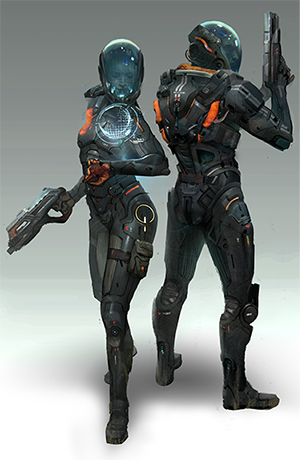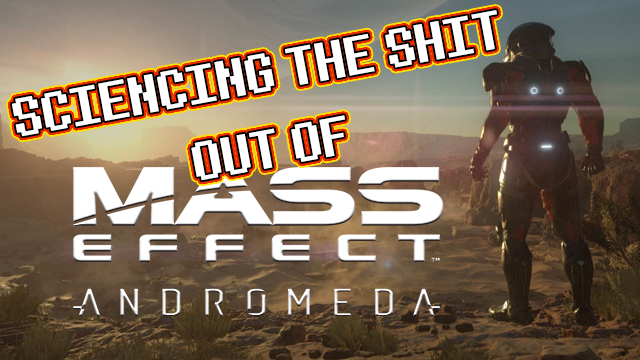I’m probably one of the few people in the universe who liked the basic mechanics of the original Mass Effect weapons. I thought that it was great that I didn’t have to worry about finding cartridges on the ground in order to replenish my ammunition. I believe that is one of the original tropes of shooters that was tired by the time that Mass Effect hit the scene. I was glad to see it gone. Of course, the cartridge system came back in Mass Effect 2, but in the game universe the guns worked on the same mechanical principles.
I do have a tiny beef with the guns of Mass Effect. Not as big of a beef as I have with the faster-than-light travel, but we can get into that on another day. The problem I have with the guns is a simple one: why is there recoil on any Mass Effect weapon?
“But it’s still a projectile weapon, Larry, of course, it’s going to have kickback, duh.”
But would it? Would it really? To answer that question, we have to examine how the weapons in the Mass Effect universe work. So let’s science the shit out of that first.

Element Zero
Everyone knows what a macguffin is, right? It’s that thing in a story that has some kind of unexplained ability that moves the plot forward. Generally, the macguffin isn’t usually important to the overall plot but it helps move everything from point A to point B. Well, Mass Effect’s macguffin is element zero. Element zero doesn’t just move the plot forward, it kind of controls everything. In fact, element zero even affected the title of the game series: Mass Effect.
Element Zero, or eezo, comes from solid matter that is affected by the energy of a dying star. Although it’s unlikely that we would discover a brand new element when mining near a supernova, we do know that many of the existing elements that aren’t hydrogen or helium were formed when stars exploded. So I’ll give BioWare an A+ on the scientific creativity here, and give them a pass on eezo on the whole. I mean, this is fiction after all — and if the only thing I have to suspend my disbelief on is this fantastical element, I’ll buy it. But that doesn’t excuse weapon recoil, yet.
According to the Mass Effect codex, eezo “releases dark energy which can be manipulated into a mass effect field, raising or lowering the mass of all objects within that field” when subjected to an electrical current. A positive charge makes the object more massive and a negative charge makes it less massive. I question the use of dark energy in the explanation of the effects of eezo. It seems that the writers are using dark energy as an anti-gravity, but that’s not exactly what it is. And for the purposes of this piece, it’s not really necessary to go into what dark energy is, but if you do want to know there’s a great video that you should watch about it.
Applying eezo to weapons
Of course, the way we hairless apes would first want to use this new discovery is by making weapons. In the Mass Effect universe, we applied this mass-reducing properties the ammunition in our guns. We take a sliver of metal, dip it in eezo, shock it with a negative current, and a explode a small bit of propellant behind it. And there you have a superfast bullet.
Thanks to the introduction of element zero, it now takes less force on the object to reach a specific acceleration. Mass, force, acceleration! Oh shit! Those are physics terms I can start plugging numbers. So let’s do that. This is simple physics, so don’t be scared.
 Let’s math
Let’s math
Let’s take a weapon we know, like the Beretta 92 series. The 124 grain (or 8.04 gram) 9 mm bullet will travel at 335 m/s out of the barrel of a Beretta 92S, the standard US Army pistol with a 127mm barrel. We can calculate the acceleration with Newtonian physics v2=v02+2as. The first v is the ending velocity. The second v is the beginning velocity, which is 0. The a is acceleration, and the s is the length of the barrel. We solve for a like this:
a=v2/2s
For the Baretta 92S the acceleration is 441830.70866141732283464566929134, or to simplify, let’s say 4.4 x 105 m/s2.
But we need another formula to calculate the force on the bullet, which is measured in newtons. And everyone should know that force equals mass time acceleration. I’m sure you have all heard that before.
F=ma
Plugging our numbers, and we get 3537.6 N. This is good times and not super big or small numbers. I can work with this. So now we know all the numbers that it takes to kill a person with a Beretta hand gun. And we also know, thanks to Newton’s third law that there is disbursed 3537.6 N pushing back on your hand. (The exact calculation for recoil is much more complicated, and there is actually a really nice wiki page on it.) For the sake of argument, let’s say that’s the amount of force that causes the kickback you see in Mass Effect, because that’s very similar to the kind of kickback that you’d see in real life.
So that would mean that if there was significantly less force applied to the bullet, there would be significantly less or no kickback.
Thanks to eezo, we can reduce the mass of the bullet. So let’s be really efficient and reduce the bullet to 1/10th its mass. Using the same amount of force as the Beretta example, that would push the bullet to 4.4 x 107 m/s2. To give you a reference, that’s over 10,000 times the speed of sound. And if resistance and gravity wasn’t a factor, you could literally shoot that bullet to the moon in less than a second. That’s insane and completely inefficient and unnecessary.

So let’s reverse that. Let’s see how many newtons it would take to push a bullet of less mass to the same speed. Our mass is 0.0804g and the acceleration we are looking for is 4.4 x 105 m/s2. Well, that’s easy, we just plug that into our force formula: F=ma, and we get, unsurprisingly 353.76 N. To put that in perspective: a ten year old is exerting that amount of force on the Earth right now by standing still. And that’s hardly enough force to push your hand back the way that Mass Effect guns do.
Now you might be thinking that they could be increasing the mass of a smaller projectile. Maybe they are, but as you can see, that would be even less efficient. And do I even have to talk about the Geth beam weapons whose projectiles have zero mass because they are literally beams? No, I don’t.
As usual, science is about testing and testing. What do you think of my hypothesis? Am I wrong? Could this be done a different way? Let me know in the comments below.







Published: May 12, 2016 12:54 pm